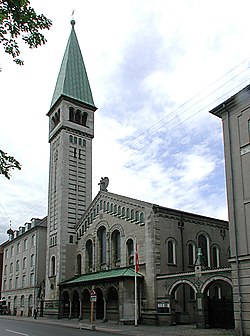
Kongens Enghave, commonly known as Sydhavnen or the postal district of 2450 Copenhagen SV (southwest) is a district in southern Copenhagen. While its core is a largely pre-WWII former working class district, it also contains an upscale residential area along the harbour having been developed after 2000, scattered industrial areas, large parks such as Valbyparken and Sydhavnstippen, allotment gardens and parts of Vestre Kirkegård, the city's largest cemetery.

Valby ( ) is one of the 10 official districts of Copenhagen Municipality, Denmark. It is in the southwestern corner of Copenhagen Municipality, and has a mixture of different types of housing. This includes apartment blocks, terraced housing, areas with single-family houses and allotments, plus the remaining part of the old Valby village, around which the district has formed, intermingled with past and present industrial sites.

Istedgade is a 1-kilometer straight street in the district of Vesterbro in the Danish capital, Copenhagen. It starts at Copenhagen Central Station and runs parallel to Vesterbrogade to Enghave Plads and Enghaveparken. From the station in the cheap hotel district, it runs through the porn, prostitution and drugs area to modern Vesterbro, where 1900s tenement style blocks have undergone significant modernisation. It is generally considered the heart of Vesterbro and was a main traffic artery until 2013 where the street had traffic reducing measures installed.
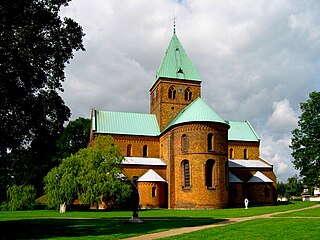
St. Bendt's Church is a church in Ringsted, Denmark, which was originally part of a Benedictine monastery that burnt down in the 18th century. Built in the Romanesque style, it is the oldest brick church in Scandinavia, dating back to about 1170 when it replaced a travertine church from about 1080. It is considered to be one of Denmark's architecturally finest churches. Furthermore, it is of special historical interest as it is the first Royal church in Denmark and it houses the tombs of many of Denmark's earlier monarchs and noblemen.

St. Mathew's Church is the oldest and largest church in the Vesterbro district of Copenhagen, Denmark. It is located at the corner of Mathæusgade and Valdemarsgade and was completed in 1880 to design by city architect Ludvig Fenger.

St. Paul's Church is a Lutheran church in central Copenhagen, Denmark, also colloquially known as Nyboder's Church due to its location in the middle of the Nyboder area. It was designed by Johannes Emil Gnudtzmann and constructed from 1872 to 1877.

Otto Valdemar Koch was a Danish architect and local politician. He designed a number of churches in Copenhagen.

St. Luke's Church is a Church of Denmark church located in the Frederiksberg district of Copenhagen, Denmark. Completed in 1897 to the design of Valdemar Koch, who also built several other churches in Copenhagen around that time, it is the second oldest church in Frederiksberg.
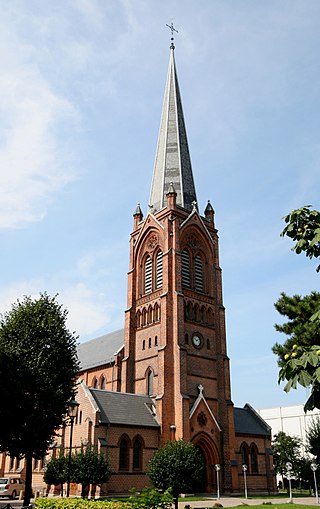
St. James's Church in the Østerbro district of Copenhagen, Denmark, was the first church to be built in the district. It was designed by Ludvig Fenger in a Neo-Gothic style and built between 1876 and 1878.

Elijah's Church is a Church of Denmark parish church located on Vesterbros Torv in the heart of the Vesterbro district of Copenhagen, Denmark. Completed in 1908 and designed by Martin Nyrop, who has designed Copenhagen City Hall, it was the largest church to be built by the Copenhagen Church Foundation.

St. Clement's Church is a parish church located in the village of Klemensker on the Danish island of Bornholm. Completed in 1882 in the Historicist style, it replaces an earlier Romanesque church from the 14th century or earlier. Today the church is noteworthy for works contributed by the Bornholm artist Paul Høm. A number of runestones have been found in the neighbourhood, two of which are now in the churchyard.

Faxe Church is a Danish church located in the Diocese of Roskilde, in Faxe, Region Sjælland on the island of Zealand. It was built at the end of the 15th century on a site where there had originally been a Romanesque church. A number of frescos, probably painted by artists from the Brarup workshop, have been uncovered on the cross vaults, most recently above the organ.

Zion's Church is a Lutheran church on Østerbrogade, just south of Svanemøllen station, in the Østerbro district of Copenhagen, Denmark. It was completed in 1896 to a design by Valdemar Koch, making it the second oldest church in Østerbro.
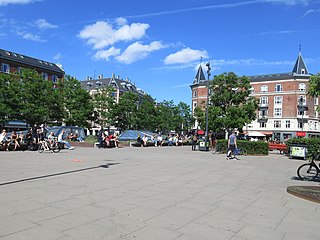
Enghave Plads is a central public square of the Vesterbro district in Copenhagen, Denmark. It is located where Istedgade reaches Enghavevej, which separates the square from Enghave Park.
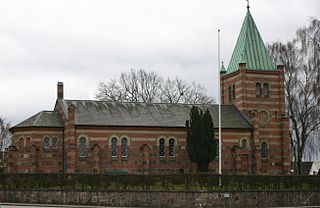
Åby Church is a church located in Åby Parish in Aarhus, Denmark. The church is situated in the neighbourhood Åbyhøj, west of Midtbyen. The church is today a parish church in the Church of Denmark, serving a parish population of 10.925 (2015). The Åby Church pastorate is shared with the Åbyhøj Church to the north.
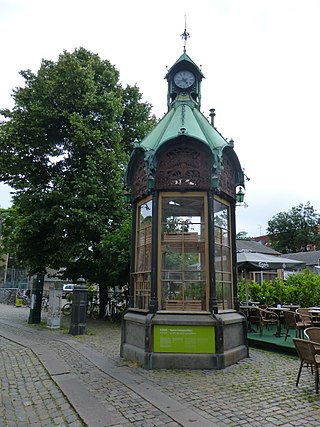
A/S Københavns Telefonkiosker, often referred to as KTK, was an operator of staffed telephone kiosks in Copenhagen, Denmark. The first telephone kiosks were installed in 1896 to an Art Nouveau-influenced National Romantic design by Fritz Koch. A new and somewhat larger model was introduced in 1913 but Koch's original design was again used when a number of new telephone kiosks were installed in 1929.

Dannebrogsgade is a street in the Vesterbro district of Copenhagen, Denmark. It runs from Vesterbrogade in the north to Sønder Boulevard in the south and passes Istedgade on the way. It is closed to car traffic both at Otto Krabbes Plads and Litauens Plads. The buildings on the east side of the street at its northern end overlooks the Shooting Range Garden.

Valdemarsgade is a street in the Vesterbro district of Copenhagen, Denmark. It runs from Vesterbrogade in the north to Sønder Boulevard in the south, intersecting Istedgade and Dybølsgade on the way. St. Matthew's Church, Vesterbro's oldest and largest church, is located in the street. Most of the street is lined with five-storey, late 18th-century apartment blocks but its northern end stands out from the surrounding neighbourhood with its low, detached buildings with small front gardens. One of the properties, De Suhrske Friboliger, is listed on the Danish registry of protected buildings and places.

Enghave Plads station is an underground Copenhagen Metro station located at Enghave Plads in the Vesterbro district of Copenhagen, Denmark. The station is on the City Circle Line (M3), between Copenhagen Central Station and Frederiksberg Allé, and is in fare zone 1. Nearby landmarks include the music venue Vega, Enghave Park and the shopping and restaurant street Istedgade.
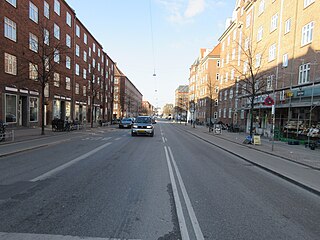
Enghavevej is a major street in the Vesterbro and Kongens Enghave districts of Copenhagen, Denmark. It runs from Vesterbrogade in the north to Sydhavns Plads in the south, linking Kingosgade with Sydhavnsgade and Borgbjergsvej.
